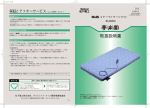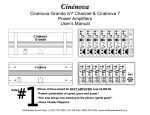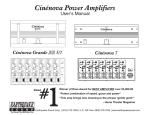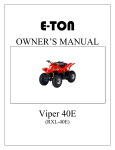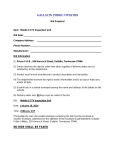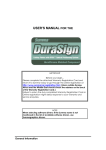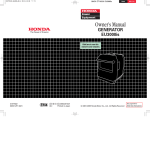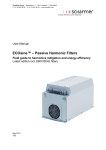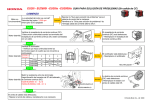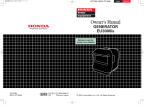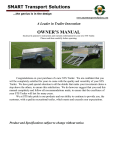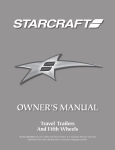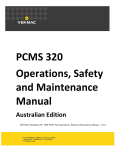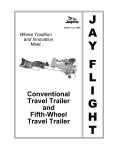Download User`s Manual PathFinder MVSAT-120
Transcript
User’s Manual PathFinder MVSAT-120 Transportable SatCom System Trailer Platform PathFinder MVSAT-120 integrated with the Winegard 1.2 Meter Auto Acquisition Mobile VSAT Antenna System PathFinder MVSAT-120 Transportable SatCom System Trailer Platform User’s Manual 11.30.08 Rev 1 Page 1 of 26 PathFinderDigital.net Table of Contents INTRODUCTION General Description Standard Features Specifications Available Options SAFETY PRECAUTIONS General Safety Information Proper Hitch Use Stabilizer & Tongue Jack Use Wiring Diagrams and Connector Type Wheel Lug Nuts Inspection & Maintenance Tire Safety Information Base Trailer Warranty Information TOWING PREPARING FOR DEPLOYMENT AND USE DEPLOYMENT AND OPERATION STOWING AND TRANSPORTATION INDIVIDUAL SUBSYSTEMS EXPLANATIONS AC Electrical System Forced Air Ventilation System Honda Generator System REQUIRED ROUTINE MAINTENANCE Wheel Bearing Maintenance Break-Away Switch Maintenance Trailer Lights & Brake Wiring Maintenance Trailer Suspension Inspection & Maintenance Door Weather Stripping Inspection & Maintenance Overall Weather Seal / Water-Proofing ADDENDUM 1 Proper Hitch Use ADDENDUM 2 Stabilizer & Tongue Jack Use ADDENDUM 3 Wiring Diagrams and Connector Type ADDENDUM 4 Wheel Lug Nuts Inspection & Maintenance ADDENDUM 5 Tire Safety Information ADDENDUM 6 Base Trailer Warranty Information PATHFINDER CONTACT INFORMATION 3 3 4 4 5 5 5 Addendum 1 Addendum 2 Addendum 3 Addendum 4 Addendum 5 Addendum 6 6 7 7 8 9 9 10 11 13 13 13 13 14 14 14 15 16 17 18 19 25 26 PathFinder MVSAT-120 Transportable SatCom System Trailer Platform User’s Manual 11.30.08 Rev 1 Page 2 of 26 PathFinderDigital.net Introduction: The PathFinder Digital Model PFD-MVSAT-120 Transportable SatCom System Platform is a compact, lightweight custom communications trailer. A rigid roof structure provides a solid platform for the installation and integration of any manufacturer’s satellite antenna system up to 1.2 meters in size. A shock mounted 15RU equipment rack is standard, providing space for the equipment necessary to render data, voice, and/or video communications. The lightweight and compact design allows for towing behind a standard SUV, van, or pickup truck that is equipped with a minimum class 1 hitch. Manually operated stabilizer jacks on all four corners offer added stability. The trailer is segmented into forward and rear compartments. The communications equipment is rack mounted in the front compartment which is sealed & locked away from the elements. The rear compartment provides plenty of space for transport and storage of other required equipment. The communications equipment, custom I/O cable hatch, and AC power input is curb side accessible. Included are two independent 120 Volt AC 15 Amp circuits and a 1400 VA UPS. The rear trunk offers 50 cubic feet of storage with ample space to carry a full sized generator, fuel can, spare tire, tools, and any ancillary equipment as needed. PathFinder Digital offers value added services that includes the installation, integration, and commissioning of customer provided equipment to render fully operational systems. PathFinder MVSAT-120 Transportable SatCom System Trailer Platform User’s Manual 11.30.08 Rev 1 Page 3 of 26 PathFinderDigital.net Standard Features: Trailer Model Manufacturer Stability Access Spare Tire Storage Rack Space I/O Interface Trailer Power Uninterruptible Power System (UPS) Air Flow Venting PFD-MVSAT-120 Transhaul / PathFinder Digital exclusive 4 stabilizing jacks on 4 corners 2 front side doors, 1 rear door Included and stored in rear trunk 50 cubic feet in rear compartment accessible via rear door Standard single 15 RU shock mounted rack in front compartment Custom 1 RU 16 port panel configurable per application on curb side of trailer 120 VAC 30 Amp twist lock plug supplying two independent 15 Amp circuits 1400VA / 950 Watt UPS included for backup of basic communication equipment Forced air ventilation in front compartment, flow-thru ventilation in rear compartment Specifications: Trailer Weight • Base Trailer (Empty) Tongue Weight • Empty • With antenna & equipment Load Capacity • GVWR • Payload Tires • Type • Load Range • Speed Rating • Max Capacity • Maximum PSI Hitch on Trailer • Tongue Type • Ball Size Hitch Requirements on Vehicle • Class 1 • Class 2 Trailer Brakes • Electric Brakes Lighting • Front Side Marker • Rear Side Marker • Rear Tail Lights 12 Volt Wiring Harness • Connector Type Trailer Dimensions • Overall Height • Overall Width • Overall Length • Body Dimensions 1,000 Lbs. approximate 90 - 100 Lbs. 125-135 Lbs. 2,990 Lbs. 1,990 Lbs. ST205/75D-15, Bias Ply Load Range C (6 Ply) Highway rated - high speed 1,820 Lbs. each 50 Lbs. A Frame rated at 5,000 Lbs. 2” Up to 200 Lbs. tongue weight Up to 2,000 Lbs. gross trailer weight Up to 300 Lbs. tongue weight Up to 3,500 Lbs. gross trailer weight Electric trailer brakes with break away switch Amber on each side Red on each side Red on the rear left & right, integrated taillights, brake lights, and turn signal lights Bargman 7 (RV Style) 12 volt electrical connectors for lights and brakes 58” 81” 128 ½” 60” Wide X 84” Long X 36” High PathFinder MVSAT-120 Transportable SatCom System Trailer Platform User’s Manual 11.30.08 Rev 1 Page 4 of 26 PathFinderDigital.net Available Options: • • • • • • • • Additional Equipment Rack Platform Tethering & Stabilization Kit WiFi Package Telescoping Mast Kit HVAC System Generator System Generator Tongue Mounting Kit Generator Trunk Transportation Kit nd 2 shock mounted rack adding 15 RU of space Secures trailer to the ground for security and windy conditions Adds high power extended range wireless broadband Stand alone 16.5’ mast system for support of hi-gain antennas & security cameras Rugged 2,000 BTU/Hr air conditioner with heat strip with custom mounting brackets Honda EU3000is 3KW Super Quiet Portable Inverter Generator Lockable protective enclosure to mount generator on tongue of trailer Ramp and fastening kit to transport generator in trunk of trailer Safety Precautions: PathFinder Digital Model PFD-MVSAT-120 Transportable SatCom System Platform is a compact, lightweight custom communications trailer designed for towing behind a standard SUV, van, or pickup truck that is equipped with a minimum class 1 hitch. The trailer is a commercial quality unit designed for use on public roadways. The trailer is not intended for off-road use. To comply with local, state, and national DOT rules and regulations, the trailer is outfitted with electric brakes wired with a Bargman 7-Post (RV Style) 12V electrical connection. The tow vehicle must be outfitted with the appropriate electrical brake system for proper operation of the trailer system. Please take note of and read carefully the addendums to this manual that include: • • • • • • Proper Hitch Use Stabilizer & Tongue Jack Use Electrical Connector Type and Wiring Diagram Wheel Lug Nuts & Bolts Maintenance & Information Tire Safety Information Basic Trailer Warranty Information Please pay special attention to on-road safety at all times. As this type of trailer system is typically outfitted with delicate and expensive electronics and electrical subsystems, please avoid sudden starts or stops (braking) and stay clear of rough terrain and/or any visible pot-holes in the roadway. When connecting the trailer’s electrical system to any form of shore power, please confirm that the power available is 120 Volts AC, 60 HZ, and 30 Amps. Connecting to any power other than the before mentioned will result in damage to the trailer’s electrical system and installed electronics. PathFinder MVSAT-120 Transportable SatCom System Trailer Platform User’s Manual 11.30.08 Rev 1 Page 5 of 26 PathFinderDigital.net Towing: • • • • • • • • • • • • • • • The trailer is to be hitched & locked to a tow vehicle equipped with a 2” ball. Attach the included safety chains to the tow vehicle’s chain loop affixed to its hitch. Connect the Bargman 7-Post Brake & Light connector to the tow vehicle’s receptacle. Attach the trailer’s break-away switch to a secure location near the hitch on the tow vehicle. Raise tongue jack into the tow position. If the wheel assembly is utilized, please remove and store. Raise and secure all four stabilizer jacks into the tow position. Stow antenna prior to any trailer movement. Detach and store away any communications cables. Detach and store away the shore power electrical extension cord. Close and lock the curb side mounted cable hatch door. Secure all communications equipment in front compartment. Close and lock the two front doors. Secure all ancillary equipment in the rear trunk compartment. Close and lock the rear door. Carefully load and distribute the weight in the trailer (front and rear compartments) for an even weight distribution over the axle. More tongue weight is desired than weight rear of the axle. Test all lights and brakes for proper operation before entering the roadway. In addition: • • If the optional tongue mounted generator is installed and utilized, detach and store away the electrical cord leading from the generator to the electrical input connector located on the curb side of the trailer. Be sure to lock the top lid in place prior to trailer movement. If the air conditioner option is installed, please be sure to attach front travel cover securely in place prior to trailer movement. As the trailer is a commercial quality unit designed for use on public roadways, please avoid offroad situations that could damage the trailer and the delicate electronics mounted inside and on top of the unit. The trailer is not intended for off-road use. On a regular basis, please check the following: o o o o o o o Proper tightening of the lug nuts on both wheels. Wheel bearing grease. Tire pressure and wear. Trailer brakes. Trailer lights. Weather stripping on all doors. Weather sealant on all bolts and roof top penetrations. Please see attached documents and/or original manufacturers’ user’s manuals for specifications and procedures on the above for information pertaining to the maintenance procedure(s) & recommendations. PathFinder MVSAT-120 Transportable SatCom System Trailer Platform User’s Manual 11.30.08 Rev 1 Page 6 of 26 PathFinderDigital.net Preparing for Deployment and Use: Upon arrival on site, perform a quick Site Survey to ensure proper operation of the system. Items to consider include: • • • • Make sure there is a clear line of site to the target satellite. Avoid trees, tall buildings, power lines, and anything that can obstruct the view to the satellite. Locate the source of electrical power. If utilizing AC electricity shore power, confirm that the outlet intended for use is of steady flow and is 120 Volts AC at 30 Amps. Locate a level location to park the trailer where it can be detached from the tow vehicle and lifted off of the ground utilizing the 4 stabilizer jacks located on the four corners of the trailer. The operational location should be within reach of the electrical power source utilizing the electrical power cord shipped with the trailer. Deployment and Operation: • • • • • • • • • • • • Park the trailer system. Chock the tires prior to detaching from tow vehicle. Detach brake / light cable and break-away switch cable from tow vehicle. Detach trailer from tow vehicle. Level the trailer system utilizing the stabilizer jacks located on the four corners of the trailer. A simple carpenter’s level can be used by placing it on the rooftop of the trailer and adjusting the jacks accordingly. For added stability for long term deployment and/or in windy conditions, the trailer can be “tied down” utilizing the four eye bolts that are located on the top four corners of the trailer just above the jacks. Connect the shore power electrical cord to the trailer and plug it in to the identified shore power AC electrical outlet. If utilizing the optional generator package, crank the generator and allow to warm & stabilize before plugging the generator into the trailer’s AC input connector. Power up the communications system by pressing the “1 Test” button on the APC UPS mounted in the bottom of the curbside rack in the front compartment. Deploy the auto acquisition satellite antenna system per the antenna manufacturer’s procedure. Upon satellite acquisition & lock, the satellite modem will auto lock and join the network. The system is now ready to use. Stabilizer jacks deployed Carpenters Level on rooftop to level Eye bolt tie-downs to stabilize platform in windy conditions AC input connector PathFinder MVSAT-120 Transportable SatCom System Trailer Platform User’s Manual 11.30.08 Rev 1 Page 7 of 26 PathFinderDigital.net Stowing and Transportation: • • • • • • • • • • • • • • Make sure rooftop is clear. Stow the antenna per the per the antenna manufacturer’s procedure. Power down the communications system by pressing the small lower, button labeled “0” on the APC UPS. Detach AC power cord from either shore power or generator. Detach any and all auxiliary equipment cables that may have been utilized. Close and lock the curbside mounted cable hatch door. Detached “tie downs” if utilized. Load all ancillary equipment into the appropriate compartments paying close attention to the distribution of the weight in the trailer (front and rear compartments) for an even weight distribution over the axle. More tongue weight is desired than weight rear of the axle. Close, latch, and lock all trailer doors. Lower trailer and raise four stabilizer jacks to the stow position. Attach the trailer to the tow vehicle. Connect the brake / light connector and the break-away switch cable to the tow vehicle. Check for proper operation of the brakes and lights on the trailer. The trailer is now ready to tow. PathFinder MVSAT-120 Transportable SatCom System Trailer Platform integrated with the Winegard 1.2 Meter Auto Acquisition Mobile VSAT Antenna System ⇐ PathFinder MVSAT-120 Transportable SatCom System Trailer Platform integrated with the AvL Technologies 1.2 Meter Auto Acquisition Mobile VSAT Antenna System ⇒ PathFinder MVSAT-120 Transportable SatCom System Trailer Platform User’s Manual 11.30.08 Rev 1 Page 8 of 26 PathFinderDigital.net Individual Subsystems Explanations: AC Electrical System: The AC electrical system in the PathFinder PFD-MVSAT-120 Transportable SatCom System Platform follows the typical RV wiring specifications. The RV specification states that the neutral conductors are not grounded; the neutral and ground must be kept separate. In the distribution / breaker box the neutral buss bar is isolated and separate from the ground buss. The reason for keeping the ground wires separated from the neutral wires is to prevent the "skin" and chassis of the coach from becoming "hot". Only the ground circuit is connected to the frame of the trailer / RV. A single 120 volt, 60 Hz, 30 Amp circuit is fed to the trailer’s AC input connector. This circuit is then fed to the distribution / breaker box where it is split in to two separate 15 Amp circuit’s. While the end user can decide how to use these circuits, a typical use is for one of the 15 Amp nd circuits to be dedicated to the communications equipment rack / equipment; and the 2 15 Amp circuit can be used amongst any and all ancillary equipment connected to the trailer. If the nd optional exterior GFI outlets are provided, these exterior outlets are integrated to the 2 15 Amp circuit to keep it isolated from the communications equipment. AC Input Optional exterior GFI AC power outlet (driver’s side) AC Distribution / Breaker Box Optional exterior GFI AC power outlet (curbside) PathFinder MVSAT-120 Transportable SatCom System Trailer Platform User’s Manual 11.30.08 Rev 1 Page 9 of 26 PathFinderDigital.net PathFinder MVSAT-120 120V AC electrical schematics: AC electrical block diagram AC electrical details 9showing optional external GFI outlets Forced Air Ventilation: The PathFinder Forced Air Ventilation System that is installed in the front compartment of the trailer will move moderate amounts of heated air from an enclosure to a point up to 5 feet away. It is a special-purpose product, designed for use in extremely tight situations where no other venting scheme will fit. It uses 4” tubing and a group of five high-quality 120mm axial-flow fans mounted within a small boxed enclosure (pictured below). This unit moves approximately 35/70CFM (cubic feet per minute, low speed/high speed) through 4" tubing. The speed of the fans is controlled by a dual thermal switch assembly, which will switch the fans on at slow speed at 90 degrees and to full speed at 100 degrees (F). The forced air fan box enclosure mounted to the side of a rack in the MVSAT-120’s front equipment compartment Interior hot air exhaust vent located on the driver’s side exterior of the MVSAT-120 PathFinder MVSAT-120 Transportable SatCom System Trailer Platform User’s Manual 11.30.08 Rev 1 Page 10 of 26 PathFinderDigital.net Honda EU3000is Generator (Optional): The PathFinder Tongue Mounted Generator Option consists of a Honda model EU3000is mounted in a lockable enclosure that is bolted to the tongue of the trailer. Generator box lid open showing generator Generator box bolted to trailer tongue The design of the generator enclosure includes a forced air ventilation system that allows for the operation of the generator with the lid closed. An exhaust fan is integrated within the generator box that pulls cool air in via louvers on the curb side and forces the hot air out of the enclosure via the large lower vent opening on the driver’s side. The upper vent allows for exhaust fumes to exit the enclosure. Please be aware that the generator enclosure can get HOT while the generator is running. Special care must be taken to avoid injury from the heat. Generator Operating Procedure: The PathFinder Generator Option includes the generator, a generator power cord, and generator tongue mounted enclosure. The flowing steps must be taken in order to power the PathFinder MVSAT-120: • • • Connect the supplied generator power cord to the generator’s 120V 30A locking power plug receptacle via the access panel on the curbside of the generator enclosure. o This system is not equipped with a transfer switch. The AC power that is input to the MVSAT-120’s AC input connector is fed direct to the system’s distribution / breaker box. Connect the opposite end of the generator power cord to the trail’s AC input connector on the curbside of the trailer. Prior to starting the generator, make sure that all electronics connected to the electrical system is protected and/or powered via the UPS or placed in the off position. PathFinder MVSAT-120 Transportable SatCom System Trailer Platform User’s Manual 11.30.08 Rev 1 Page 11 of 26 PathFinderDigital.net • Start the generator. The Honda EU3000 generator is equipped with electric start and pull rope backup starting. Please refer to the Honda EU3000 Owner’s Manual for proper starting, stopping, and operating procedures. Routine Maintenance must be preformed on the generator per the Owner’s Manual. To perform routine maintenance on the generator, the generator must first be removed from the tongue mounted enclosure as follows: • • • • • Remove the four nuts on the underside of the generator enclosure using a socket wrench. Carefully remove the electrical plug from the generator’s DC receptacle. This is the supply voltage to the enclosure’s exhaust fan. Two people must now lift the generator out of the enclosure utilizing the handles located on the top sides of the generator. Place the generator in a clean & dry location and perform routine maintenance per the Honda User’s Manual. Upon completion of necessary maintenance, place generator back in the enclosure, plug fan’s DC power cord back into the generator’s DC Receptacle, replace and tighten the four nuts on the studs on the underside of the generator enclosure. Generator Specifications: • • • • • • • • • • • • • • • 3,000 watts max. (25A) 2,800 watts rated (23.3A) DC Output: 12V, 144W (12A) Engine: 6.5 HP, 4 stroke, Single cylinder, overhead valve, air-cooled Starter: Recoil and Electric Noise level: 53-58 dB (1/4 load & Rated load) 60dB is normal speech! Weight: 134lbs. Dry Fuel tank size: 3.4 gallons Run time: 7.1 hrs. at rated load! DC output (Requires optional cable) 25.8" x 18.9" x 22.4" Dimensions (LxWxH) Eco-Throttle - Engine RPM adjusts to amperage draw. Low oil shut down Electronic breaker Honda inverter technology provides a pure sine wave High quality power output. The precision of Honda's inverter technology ensures its power is closer to "line power" more than any other generator design. Honda 's inverter technology takes the raw power produced by the generator and uses a special microprocessor to condition it through a multi-step process. First, the generator's alternator produces high voltage multiphase AC power. The AC power is then converted to DC. Finally the DC power is converted back to AC by the inverter. The inverter also smoothes and cleans the power to make it high quality. A special microprocessor controls the entire process, as well as the speed of the engine. PathFinder MVSAT-120 Transportable SatCom System Trailer Platform User’s Manual 11.30.08 Rev 1 Page 12 of 26 PathFinderDigital.net REQUIRED ROUTINE MAINTENANCE: Wheel Bearing Inspection & Maintenance: One of the most important items to maintain on a trailer are the wheel bearings. The wheel bearings should have enough lubricant (wheel bearing grease) and the tapered wheel bearings should have the correct adjustment. The procedure for checking wheel bearing tightness is as follows: Block the trailer on a level spot so it cannot move, raise the trailer one side at the time. Raise it up just enough so that the wheels are free to rotate. Check for wheel play (looseness) by placing on hand at front and one at the rear of the tire and rock it back and forth. If there is play remove the axle cap with a sharp object such as a screwdriver or fine chisel. Under the axle cap there is a castellated nut with a cotter pin or a special washer (EZ lube spindle). The cotter pin must be straightened and pulled out and the EZ lube washer tabs must be pried up and out of the way of the nut so that the nut can be tightened. Tighten the castle nut one notch at the time then rotate the wheel. There should be a little resistance on the wheel when it is rotated. Too much resistance will cause the bearing to overheat. Finally, to install the axle cap, line the cap up straight with hub, using a drift (hammer) and a wooden spacer such as a short piece of 2"x4" material drive the axle cap on. Hammer it straight on. Do not hammer directly onto the axle cap as it will become damaged. Let trailer down, remove jack and apply the same procedure to the other side. Break-Away Kit Inspection & Maintenance: Trailers with electric brakes have a break-a-way kit including battery, battery box, break away switch with attached plunger and cable. The theory is that if your coupler becomes separated from the tow ball the plunger of the breakaway switch will come out thereby completing the electrical circuit, allowing the battery to provide power to the electric brakes and bringing your trailer to a stop. This will work of course provided there is adequate power in the battery and provided your breakaway switch cable is properly attached to the towing vehicle. It is important to charge the battery periodically and it is recommended that you check the battery charge level with each seasonal change. If the wet cell battery does not keep adequate charge it can freeze in the winter months and become useless. The breakaway switch cable itself should be attached to its own anchor in order to provide the correct amount of play, not too loose or too tight. Trailer Wiring & Electric Brake Inspection & Maintenance: In spite of continued improvements in trailer wiring and electrical components, wiring problems can occur if regular maintenance is avoided. Many of the problems with trailers’ electrical system stem from the conditions under which many trailers are operating in. Under gravel road conditions the underside of the trailer is being bombarded by an abrasive mixture of sand and stone (gravel). The trailer is literally being sandblasted. This sandblasting effect can damage the wiring underneath the trailer. The most common problems are with the electrical wires coming out of the electric brakes. It is important to inspect the wiring on a regular basis to make sure the wires are clean and tucked up in position and not dangling in a vulnerable position. Under winter conditions it is important that the wiring behind the brake drums does not ice up. It is a good idea to wash the underneath to remove corrosive salts, road gravel and other corrosive materials that may be present. Other causes of wiring problems are poor grounding or poor contacts in the truck end or trailer end electrical plugs. Often there is corrosion on the electrical plug terminals and that prevents proper electrical conduction. It is a good idea to spray the electrical plugs with a good penetrating fluid or WD40 to help dissolve the built up corrosion. Always check the electrical ground as part of your check list if your trailers electrical system is not working properly. PathFinder MVSAT-120 Transportable SatCom System Trailer Platform User’s Manual 11.30.08 Rev 1 Page 13 of 26 PathFinderDigital.net Trailer Suspension Inspection & Maintenance: Regular maintenance on your trailer should include attention to the suspension components. There are many moving and therefore wearing parts that form the trailers suspension. A typical conventional tandem axle trailer contains hangers, leaf springs, shackle straps, shackle bolts, equalizers, u-bolts, and axle plates to name a few. The leaf springs and equalizers usually contain Teflon bushings to extend the life of the suspension components. These bushings, shackle straps and bolts will eventually wear out and will need to be replaced. This procedure should be regarded as normal operational maintenance. Periodic inspection of these components can avert problems such as premature tire wear. Extreme wear of these components can cause the trailer to wonder behind the towing vehicle resulting in serious instability. Trailer Door Weather Seal / Stripping Inspection & Maintenance: The weather stripping around all doors should be inspected and treated with a silicone lubricant spray on a regular basis. A product such as WD-40 Silicon Spray should be applied to the rubber stripping to protect from dry rotting and corrosion resistance. In addition, if the weather stripping should begin to pull lose from the door frame, a rubber type adhesive can be applied to the weather stripping to reseal to the door. A product such as 3M Scotch-Grip Rubber and Gasket Adhesive can be used for this purpose. Overall Weather Seal / Water-Proofing: Periodically inspect all cable points of entry and any surface on trailer exterior that has been penetrated for proper weather sealing. If any leaks are present, or any cracks can be seen in existing weather seal, please re-apply with a silicon based all weather type caulking. PathFinder MVSAT-120 Transportable SatCom System Trailer Platform User’s Manual 11.30.08 Rev 1 Page 14 of 26 PathFinderDigital.net ADDENDUM 1 PROPER HITCH USE OPERATION INSTRUCTIONS POSI-LOCK COUPLER ADJUST COUPLER LOCKING PRESSURE ON BALL BEFORE USE. PLACE HANDLE IN LOCKED POSITION WITH BALL IN COUPLER. TIGHTEN LOCKNUT AGAINST TENSION SPRING SO THAT COUPLER IS NOT LOOSE ON BALL. CORRECT ADJUSTMENT WILL ALLOW HANDLE TO BE RELEASED WITH MODERATE PRESSURE APPLIED TO HANDLE. TO OPEN, PULL UP ON COUPLER HANDLE AND ROTATE FORWARD. PLACE COUPLER ON BALL WHEN BALL IS COMPLETELY NESTED IN BALL SOCKET, ROTATE COUPLER HANDLE BACKWARD UNTIL HANDLE IS IN LOCKED POSITION. AFTER TOWING FOR 50 MILES, CHECK COUPLER FOR TIGHTNESS ON BALL. ALWAYS CHECK TIGHTNESS BEFORE TOWING. BE SURE COUPLER HANDLE IS IN LOCKED POSITION. WARNING: NEVER EXCEED WEIGHT CAPACITY AND ALWAYS USE SAFETY CHAINS. ALWAYS USE CORRECT BALL SIZE, MAKING SURE BALL IS COMPLETELY INSERTED INTO COUPLER. LOCK COUPLER HANDLE SECURELY BEFORE TOWING. ALWAYS CHECK FOR DAMAGES AND REPLACE IF DAMAGED. AVOID SHARP TURNS AND STEEP VERTICAL ANGLES WHEN TOWING. PathFinder MVSAT-120 Transportable SatCom System Trailer Platform User’s Manual 11.30.08 Rev 1 Page 15 of 26 PathFinderDigital.net ADDENDUM 2 Stabilizer & Tongue Jack Use Before cranking jack or coupling trailer, secure trailer from rolling. These jacks are designed for upright loading, unnecessary side forces must be avoided. Re: Tongue Jack: when physically moving a trailer over coarse or unpaved surfaces, crank the jack to the lowest convenient position to minimize bending pressure on jack. MAINTENANCE The inner gearings and bearings of the jack must be kept lubricated. Using a needle nose applicator, pump a small amount of automotive grease through the lubrication hole. The lubrication hole can be found on the side of the jack tube, right above the support plate. Alternate the jack handle to distribute the grease consistently. Lightly grease the inner tube of the jack using the same type of grease. Light weight oil must be applied to the handle at both sides of the tube. The axle bolt and nut assembly of the caster wheel of the tongue jack must also be lubricated with the equivalent light weight oil. OPERATING INFORMATION Interchange the jack handle clockwise to raise the jack, or counterclockwise to lower the jack. Note: If the caster does not have ground contact, it is necessary to keep the caster from revolving when cranking the jack handle. PathFinder MVSAT-120 Transportable SatCom System Trailer Platform User’s Manual 11.30.08 Rev 1 Page 16 of 26 PathFinderDigital.net ADDENDUM 3 WIRING DIAGRAMS FOR BARGMAN 7 (RV STYLE) 12V ELECTRICAL CONNECTORS PathFinder MVSAT-120 Transportable SatCom System Trailer Platform User’s Manual 11.30.08 Rev 1 Page 17 of 26 PathFinderDigital.net ADDENDUM 4 NOTICE DRIVER – DEALER – OWNER CHECK WHEELS NUTS OR BOLTS IT IS RECOMMEDED THAT TIRES BE BALANCED AND CHECKED PERIODICALLY. FIRST TRIP – CHECK NUTS OR BOLTS AT START, 50, 150, & 300 MILES. TIGHTEN TO 85-95 FT. LBS OF TORQUE. CHECK RUNNING GEAR NUTS AND/OR BOLTS AT START 50, 150, & 300 MILES. AFTER FIRST TRIP PERIODICALLY. – CHECK WHEEL NUTS OR BOLTS CHECK RUNNING GEAR NUTS AND/OR BOLTS PERIODICALLY AFTER FIRST TRIP. AFTER ANY PERIOD OF STORAGE – BEFORE A TRIP, ALWAYS CHECK WHEEL NUTS OR BOLTS, RUNNING GEAR NUTS AND/OR BOLTS, AND TIRE PRESSURE. CHECK BEARINGS FOR PROPER LUBRICATION EVERY 6 MONTHS. USE NLGI GRADE #2 GREASE WITH E.P. ADDITIVE. DO NOT EXCEED POSTED PAYLOAD CAPACITY. PathFinder MVSAT-120 Transportable SatCom System Trailer Platform User’s Manual 11.30.08 Rev 1 Page 18 of 26 PathFinderDigital.net ADDENDUM 5 1.0. SAFETY FIRST–BASIC TIRE MAINTENANCE Properly maintained tires improve the steering, stopping, traction, and load-carrying capability of your vehicle. Underinflated tires and overloaded vehicles are a major cause of tire failure. Therefore, as mentioned above, to avoid flat tires and other types of tire failure, you should maintain proper tire pressure, observe tire and vehicle load limits, avoid road hazards, and regularly inspect your tires. 1.0.1. FINDING YOUR VEHICLE'S RECOMMENDED TIRE PRESSURE AND LOAD LIMITS Tire information placards and vehicle certification labels contain information on tires and load limits. These labels indicate the vehicle manufacturer's information including: • • • • Recommended tire size Recommended tire inflation pressure Vehicle capacity weight (VCW–the maximum occupant and cargo weight a vehicle is designed to carry) Front and rear gross axle weight ratings (GAWR– the maximum weight the axle systems are designed to carry). Both placards and certification labels are permanently attached to the trailer near the left front. 1.0.2. UNDERSTANDING TIRE PRESSURE AND LOAD LIMITS Tire inflation pressure is the level of air in the tire that provides it with load-carrying capacity and affects the overall performance of the vehicle. The tire inflation pressure is a number that indicates the amount of air pressure– measured in pounds per square inch (psi)–a tire requires to be properly inflated. (You will also find this number on the vehicle information placard expressed in kilopascals (kpa), which is the metric measure used internationally.) Manufacturers of passenger vehicles and light trucks determine this number based on the vehicle's design load limit, that is, the greatest amount of weight a vehicle can safely carry and the vehicle's tire size. The proper tire pressure for your vehicle is referred to as the "recommended cold inflation pressure." (As you will read below, it is difficult to obtain the recommended tire pressure if your tires are not cold.) Because tires are designed to be used on more than one type of vehicle, tire manufacturers list the "maximum permissible inflation pressure" on the tire sidewall. This number is the greatest amount of air pressure that should ever be put in the tire under normal driving conditions. 1.0.3. CHECKING TIRE PRESSURE It is important to check your vehicle's tire pressure at least once a month for the following reasons: • • • Most tires may naturally lose air over time. Tires can lose air suddenly if you drive over a pothole or other object or if you strike the curb when parking. With radial tires, it is usually not possible to determine under inflation by visual inspection. PathFinder MVSAT-120 Transportable SatCom System Trailer Platform User’s Manual 11.30.08 Rev 1 Page 19 of 26 PathFinderDigital.net For convenience, purchase a tire pressure gauge to keep in your vehicle. Gauges can be purchased at tire dealerships, auto supply stores, and other retail outlets. The recommended tire inflation pressure that vehicle manufacturers provide reflects the proper psi when a tire is cold. The term cold does not relate to the outside temperature. Rather, a cold tire is one that has not been driven on for at least three hours. When you drive, your tires get warmer, causing the air pressure within them to increase. Therefore, to get an accurate tire pressure reading, you must measure tire pressure when the tires are cold or compensate for the extra pressure in warm tires. 1.0.4. STEPS FOR MAINTAINING PROPER TIRE PRESSURE • • • • • • Step 1: Locate the recommended tire pressure on the vehicle's tire information placard, certification label, or in the owner's manual. Step 2: Record the tire pressure of all tires. Step 3: If the tire pressure is too high in any of the tires, slowly release air by gently pressing on the tire valve stem with the edge of your tire gauge until you get to the correct pressure. Step 4: If the tire pressure is too low, note the difference between the measured tire pressure and the correct tire pressure. These "missing" pounds of pressure are what you will need to add. Step 5: At a service station, add the missing pounds of air pressure to each tire that is underinflated. Step 6: Check all the tires to make sure they have the same air pressure (except in cases in which the front and rear tires are supposed to have different amounts of pressure). If you have been driving your vehicle and think that a tire is underinflated, fill it to the recommended cold inflation pressure indicated on your vehicle's tire information placard or certification label. While your tire may still be slightly underinflated due to the extra pounds of pressure in the warm tire, it is safer to drive with air pressure that is slightly lower than the vehicle manufacturer's recommended cold inflation pressure than to drive with a significantly underinflated tire. Since this is a temporary fix, don't forget to recheck and adjust the tire's pressure when you can obtain a cold reading. 1.0.5. TIRE SIZE To maintain tire safety, purchase new tires that are the same size as the vehicle's original tires or another size recommended by the manufacturer. Look at the tire information placard, the owner's manual, or the sidewall of the tire you are replacing to find this information. If you have any doubt about the correct size to choose, consult with the tire dealer. 1.0.6. TIRE TREAD The tire tread provides the gripping action and traction that prevent your vehicle from slipping or sliding, especially when the road is wet or icy. In general, tires are not safe and should be replaced when the tread is worn down to 1/16 of an inch. Tires have built-in tread-wear indicators that let you know when it is time to replace your tires. These indicators are raised sections spaced intermittently in the bottom of the tread grooves. When they appear "even" with the outside of the tread, it is time to replace your tires. Another method for checking tread depth is to place a penny in the tread with Lincoln's head upside down and facing you. If you can see the top of Lincoln's head, you are ready for new tires. PathFinder MVSAT-120 Transportable SatCom System Trailer Platform User’s Manual 11.30.08 Rev 1 Page 20 of 26 PathFinderDigital.net 1.0.7. TIRE BALANCE AND WHEEL ALIGNMENT To avoid vibration or shaking of the vehicle when a tire rotates, the tire must be properly balanced. This balance is achieved by positioning weights on the wheel to counterbalance heavy spots on the wheel-and-tire assembly. A wheel alignment adjusts the angles of the wheels so that they are positioned correctly relative to the vehicle's frame. This adjustment maximizes the life of your tires. These adjustments require special equipment and should be performed by a qualified technician. 1.0.8. TIRE REPAIR The proper repair of a punctured tire requires a plug for the hole and a patch for the area inside the tire that surrounds the puncture hole. Punctures through the tread can be repaired if they are not too large, but punctures to the sidewall should not be repaired. Tires must be removed from the rim to be properly inspected before being plugged and patched. 1.0.9. TIRE FUNDAMENTALS Federal law requires tire manufacturers to place standardized information on the sidewall of all tires. This information identifies and describes the fundamental characteristics of the tire and also provides a tire identification number for safety standard certification and in case of a recall. 1.0.9.1. Information on Passenger Vehicle Tires Please refer to the diagram below. P The "P" indicates the tire is for passenger vehicles. PathFinder MVSAT-120 Transportable SatCom System Trailer Platform User’s Manual 11.30.08 Rev 1 Page 21 of 26 PathFinderDigital.net Next number This three-digit number gives the width in millimeters of the tire from sidewall edge to sidewall edge. In general, the larger the number, the wider the tire. Next number This two-digit number, known as the aspect ratio, gives the tire's ratio of height to width. Numbers of 70 or lower indicate a short sidewall for improved steering response and better overall handling on dry pavement. R The "R" stands for radial. Radial ply construction of tires has been the industry standard for the past 20 years. Next number This two-digit number is the wheel or rim diameter in inches. If you change your wheel size, you will have to purchase new tires to match the new wheel diameter. Next number This two- or three-digit number is the tire's load index. It is a measurement of how much weight each tire can support. You may find this information in your owner's manual. If not, contact a local tire dealer. Note: You may not find this information on all tires because it is not required by law. M+S The "M+S" or "M/S" indicates that the tire has some mud and snow capability. Most radial tires have these markings; hence, they have some mud and snow capability. Speed Rating The speed rating denotes the speed at which a tire is designed to be driven for extended periods of time. The ratings range from 99 miles per hour (mph) to 186 mph. These ratings are listed below. Note: You may not find this information on all tires because it is not required by law. Letter Rating Q R S T U H V W Y Speed Rating 99 mph 106 mph 112 mph 118 mph 124 mph 130 mph 149 mph 168* mph 186* mph * For tires with a maximum speed capability over 149 mph, tire manufacturers sometimes use the letters ZR. For those with a maximum speed capability over 186 mph, tire manufacturers always use the letters ZR. U.S. DOT Tire Identification Number This begins with the letters "DOT" and indicates that the tire meets all federal standards. The next two numbers or letters are the plant code where it was manufactured, and the last four numbers represent the week and year the tire was built. For example, the numbers 3197 means the 31st week of 1997. The other numbers are marketing codes used at the manufacturer's discretion. This information is used to contact consumers if a tire defect requires a recall. PathFinder MVSAT-120 Transportable SatCom System Trailer Platform User’s Manual 11.30.08 Rev 1 Page 22 of 26 PathFinderDigital.net Tire Ply Composition and Materials Used The number of plies indicates the number of layers of rubber-coated fabric in the tire. In general, the greater the number of plies, the more weight a tire can support. Tire manufacturers also must indicate the materials in the tire, which include steel, nylon, polyester, and others. Maximum Load Rating This number indicates the maximum load in kilograms and pounds that can be carried by the tire. Maximum Permissible Inflation Pressure This number is the greatest amount of air pressure that should ever be put in the tire under normal driving conditions. 1.0.9.2. UTQGS Information Treadwear Number This number indicates the tire's wear rate. The higher the treadwear number is, the longer it should take for the tread to wear down. For example, a tire graded 400 should last twice as long as a tire graded 200. Traction Letter This letter indicates a tire's ability to stop on wet pavement. A higher graded tire should allow you to stop your car on wet roads in a shorter distance than a tire with a lower grade. Traction is graded from highest to lowest as "AA","A", "B", and "C". Temperature Letter This letter indicates a tire's resistance to heat. The temperature grade is for a tire that is inflated properly and not overloaded. Excessive speed, underinflation or excessive loading, either separately or in combination, can cause heat build-up and possible tire failure. From highest to lowest, a tire's resistance to heat is graded as "A", "B", or "C". 1.0.9.3. Additional Information on Light Truck Tires Tires for light trucks have other markings besides those found on the sidewalls of passenger tires. LT The "LT" indicates the tire is for light trucks or trailers. ST An "ST" is an indication the tire is for trailer use only. Max. Load Dual kg (lbs) at kPa (psi) Cold This information indicates the maximum load and tire pressure when the tire is used as a dual, that is, when four tires are put on each rear axle (a total of six or more tires on the vehicle). Max. Load Single kg (lbs) at kPa (psi) Cold This information indicates the maximum load and tire pressure when the tire is used as a single. Load Range This information identifies the tire's load-carrying capabilities and its inflation limits. PathFinder MVSAT-120 Transportable SatCom System Trailer Platform User’s Manual 11.30.08 Rev 1 Page 23 of 26 PathFinderDigital.net 1.1. TIRE SAFETY TIPS Preventing Tire Damage • • Slow down if you have to go over a pothole or other object in the road. Do not run over curbs or other foreign objects in the roadway, and try not to strike the curb when parking. Tire Safety Checklist • • • • • • Check tire pressure regularly (at least once a month), including the spare. Inspect tires for uneven wear patterns on the tread, cracks, foreign objects, or other signs of wear or trauma. Remove bits of glass and foreign objects wedged in the tread. Make sure your tire valves have valve caps. Check tire pressure before going on a long trip. Do not overload your vehicle. Check the Tire Information and Loading Placard or User’s Manual for the maximum recommended load for the vehicle. PathFinder MVSAT-120 Transportable SatCom System Trailer Platform User’s Manual 11.30.08 Rev 1 Page 24 of 26 PathFinderDigital.net ADDENDUM 6 PathFinder MVSAT-120 Transportable SatCom System Trailer Platform Base Trailer Platform Warranty The base trailer platform of the PathFinder MVSAT-120 is manufactured under an exclusive arrangement for PathFinder Digital, LLC by Transhaul, Inc. Transhaul is a reputable cargo trailer manufacturer located in Douglas, GA and is a member of the National Association of Trailer Manufacturers (NATM). PathFinder Digital, LLC passes the base trailer warranty conditions on to the purchaser per the following Transhaul Warranty Statements and Conditions: Transhaul, Inc., 125 Westgate Drive, Douglas, GA 31535 (warrantor) warrants to PathFinder Digital, LLC which is passed on to the ORIGINAL CONSUMER PURCHASER (purchaser) for a period of one (1) year from the date of purchase by (purchaser warranty period), that its trailer (the product) shall be free of defects in materials and workmanship attributable to warrantor. THE ONE YEAR WARRANTY INCLUDES: This one (1) year warranty includes electrical, doors, seals, sealant, paint, undercoating, plastic and fiberglass parts for a one (1) year period from the date of purchase by the ORIGINAL purchaser. EXCLUDED FROM WARRANTY: Warrantor is not responsible for claims relating to the following: (1) defacing: scratches, dents, chips, tears, and defacing on any surface not caused by Warrantor; (2) routine maintenance; (3) damage from unauthorized repairs, abuse, misuse or neglect; (4) damage caused from improper hitch ball or tow vehicle hook up; (5) component parts covered by separate Supplier Warranty such as warranties of the manufacturer of tires, axles, jacks, couplers, windows, light fixtures, etc.; (6) additions or modifications to trailer other than by Transhaul. WARRANTOR’S OBLIGATION – HOW TO GET WARRANTY SERVICE: Warrantor may, as its option, select another qualified location for the repair to be completed. Warrantor will not be obligated in any way, to pay for any repairs made without its specific approval. Warrantor shall remedy defects within a reasonable time, not to exceed sixty (60) days after delivery by Purchaser. PathFinder MVSAT-120 Transportable SatCom System Trailer Platform User’s Manual 11.30.08 Rev 1 Page 25 of 26 PathFinderDigital.net SERVICE INFORMATION For all service needs, please contact PathFinder Digital, LLC toll free at: 1-888-650-1838 Prompt the operator and ask for MVSAT Technical Support & Service. PathFinder’s Network Operations & Technical Support Center is located at: PathFinder Digital, LLC. Telford-Hulsey Business Park 82 Enterprise Lane Cleveland, GA 30528 PathFinder MVSAT-120 Transportable SatCom System Trailer Platform User’s Manual 11.30.08 Rev 1 Page 26 of 26 PathFinderDigital.net


























